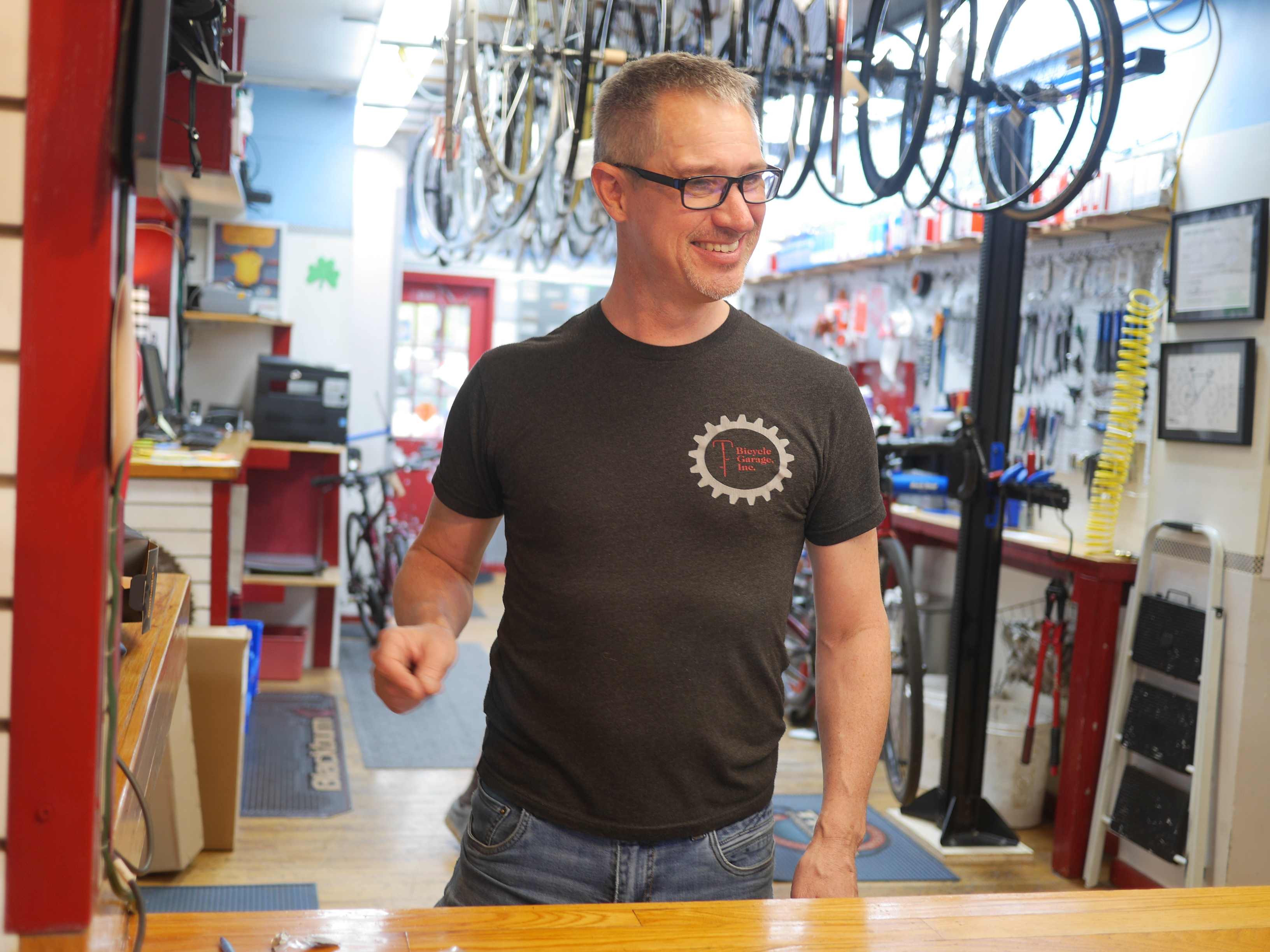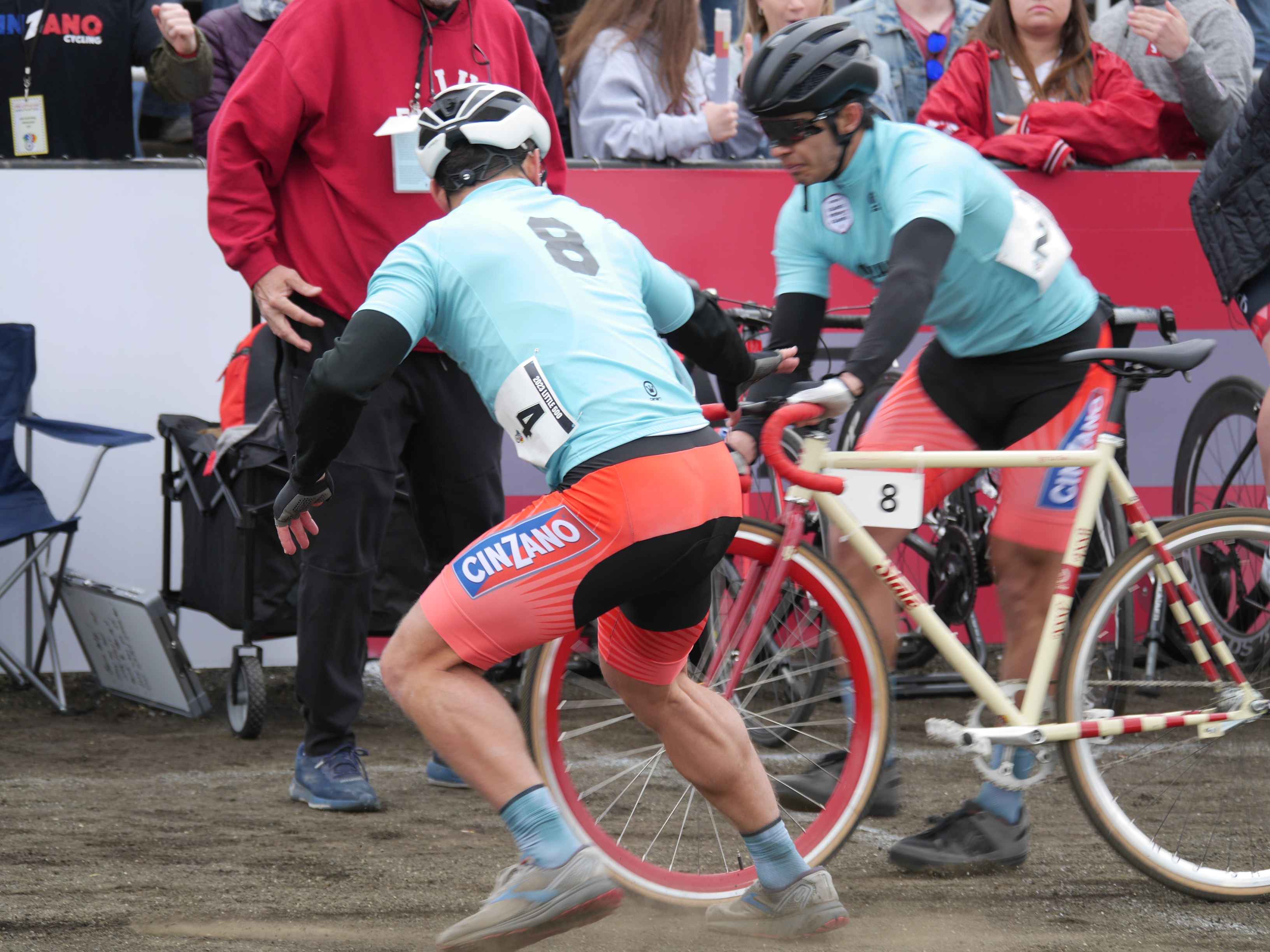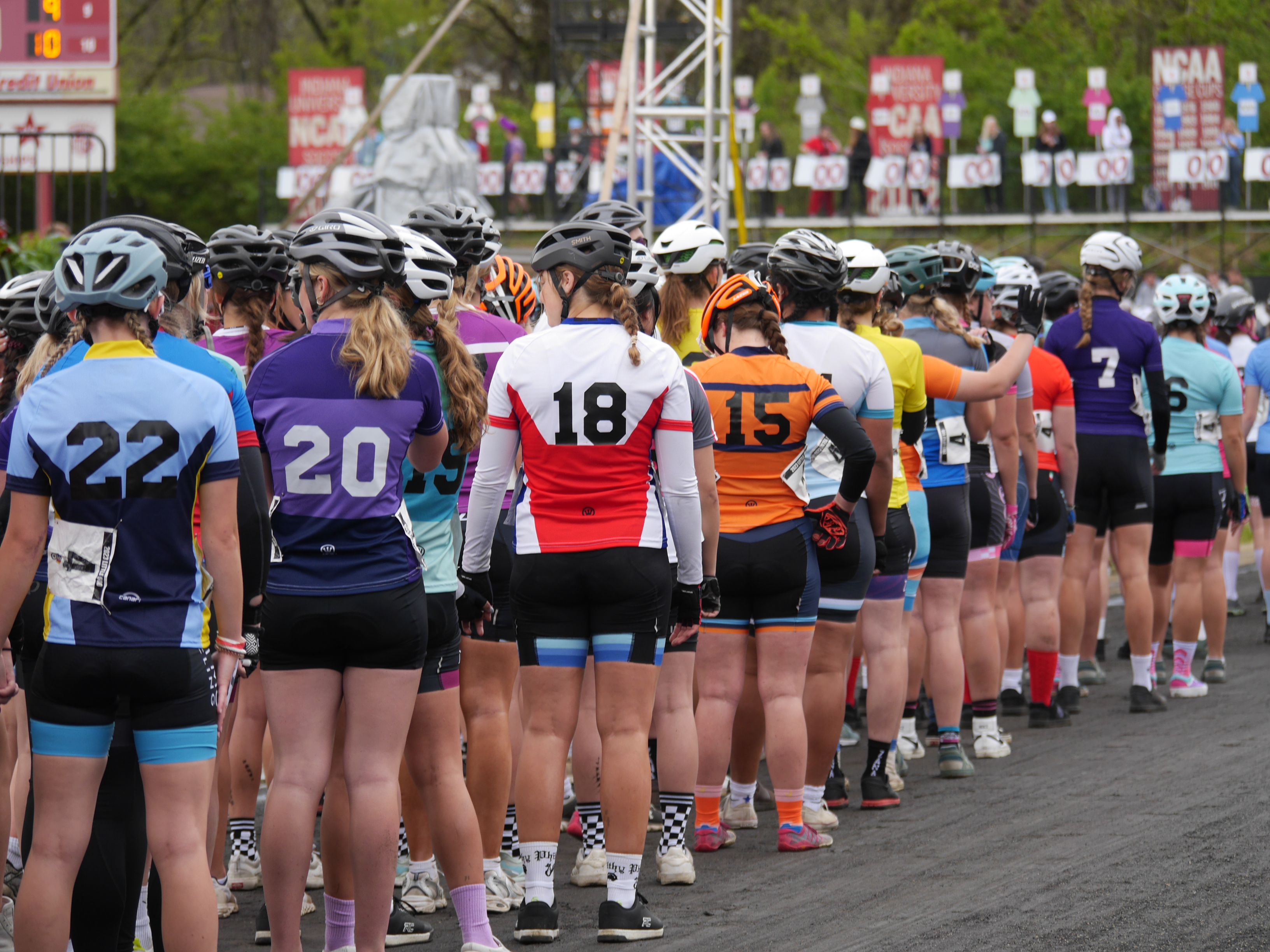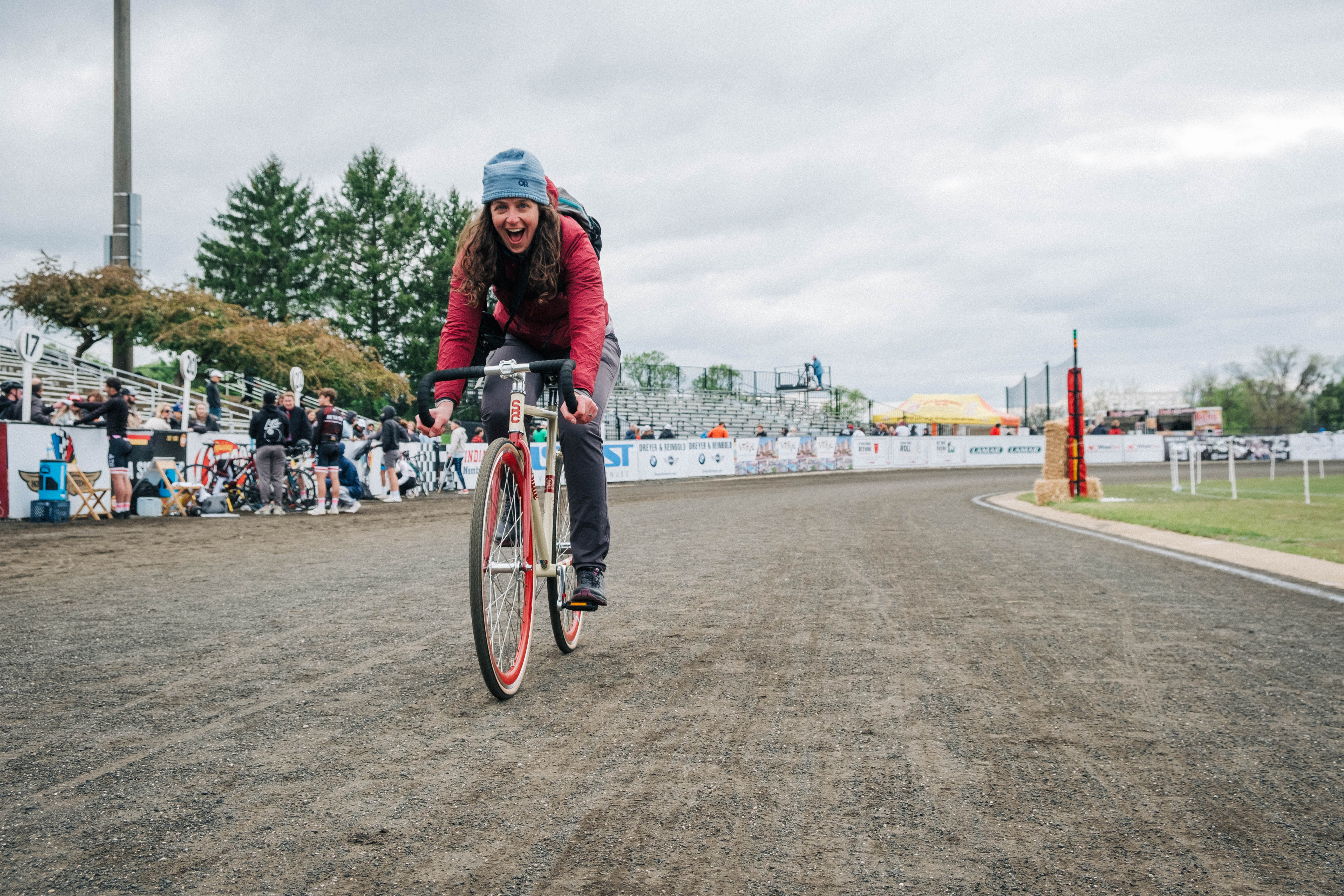The Little 500 is coolest bike race you’ve never been to
Niche yet popular, this Midwest bike race was once attended by President Obama and Lance Armstrong


It’s a balmy Thursday in April in Bloomington, Indiana (population 79,968), and the campus at Indiana University (student population 45,328) is buzzing with activity. The dogwood and redbud trees are blooming, the planters have been filled with red and white flowers, and students are taking photos in advance of graduation just a few weeks away. But unlike any other college campus in the United States, this one is on the eve of hosting the largest collegiate cycling event in the world, one that has been running annually since 1951, and whose participants are all undergraduate students from IU. Made famous by the 1979 film Breaking Away – a cult favorite among cycling fans – the Little 500 is a relay race like no other, held on a cinder track, featuring standard-issue singlespeed coaster brake bikes, chaotic and beautiful bike exchanges, and a raucous crowd of students filling the grandstands behind their team’s pit in matching shirts, chanting for their riders.

3 P.M. Thursday: Teams roll through campus on their way out for training rides. Cheers erupt, none louder than from the 1988 Willkie Sprint team, winners of the first-ever women’s edition of the race 35 years ago. They’ve come from across the country and as far away as Italy for a reunion, and to serve as Grand Marshals of this year’s event. The four women – Amy Tucker, Kerry Hellmuth, Kirsten Swanson, and Louise Elder – who were all first-year college students that year, are joined by Kevin Wentz and Kristen McArdle, upper-term students who were their residence hall advisors and coaches that year. They’ve filled their luggage with memorabilia: photo albums, newspaper clippings, beat-up old Vittoria road shoes from training rides, and one of the team jerseys they wore. Kerry pulls it on, noting that while they had qualified 8th, no other team before them picked yellow, the color they had coveted. They pose for photos, laugh and hug, and stroll down Kirkwood Avenue from the campus gates to the strip of bars, soaking in the atmosphere.

5 P.M. Thursday: Wilkie Sprint has a meet-and-greet with Teter, the top women’s dorm team and winners of the Spring Series of races. Their team, consisting of two rookies and two veteran riders, was second in the qualifying race, and was joined by their student coaches, who are veteran riders. Kerry imparts on Teter the same advice Kevin had given them at the pasta dinner the night before their 1988 race: “You have to believe you can win.” The Wilkie Sprint riders pepper the team with questions and stories, including showing them the bits of cinder from the track they still have embedded in their kneecaps 35 years later.
10 A.M. Friday: As Wilkie Sprint gathers for brunch on a cold and rainy morning, they humor this reporter with talk about race strategy, what they’ll be looking for in the races, and what participating in the Little 500 meant to them. Louise had not been an athlete prior to participating, and says it gave her confidence for the rest of her life. Kristen, one of their coaches that year, went on to a career in sports marketing, and no matter the prestige of the events she worked on (including many Olympic games), the Little 500 remains the most unique and special. Kerry, who had been a high school triathlete, found her home in cycling, going on to race professionally for the Italian Master Team Carpe Diem squad with appearances in the Giro Feminina and the Grand Boucle before leading tours through Italy for her good friend and Giro winner Andy Hampsten. Kirsten, who had been a runner in her youth, went on to a career in the military and continued to compete in triathlons. Amy, a childhood friend of Kirsten’s, joined Wilkie Sprint after losing her spot on the IU cross-country running team. From not having a bike to going on to an impressive racing career on the velodrome and the road, she credits the Little 500 experience with keeping her in college and setting her on a lifelong trajectory as a cyclist. Kevin, who went on to coach basketball for 35 years, said he knew right away that he had a special group of athletes in that 1988 team. All six are excited to see how the strategy has evolved, and whether a team manages to lap the field–a bold, difficult, and effective strategy for winning.

12:30 P.M. Friday: The Gray Goat men’s team waits at an intersection at the city square, hoping to catch a break in the cold rain for their shakedown ride. It has been raining heavily all morning, putting the start time of the women’s race in question. When asked about their goals for the race, first-year Colten Seiler (Zionsville, Indiana) and senior Michael Sears (Indianapolis, Indiana) say they’re “dreaming big.”
2 P.M. Friday: At the Bicycle Garage on Kirkwood, Fred Rose is answering phones, helping customers, and keeping the shop humming. He’s a Cinzano alum from the ‘80s–yes, there’s a Cinzano team, in homage to “the Italians” from Breaking Away. He’s been a coach, a mechanic, and otherwise involved in the Little 5 for decades. Now in his fifties, he employs several current racers, including Cutters team captain, Peyton Gaskill (yes, there’s also a Cutters team; with 14 wins, they have won more editions than any other team and hope to make it 15 this weekend).
Fred’s first bike race was as a rookie in the Little 500, and in three decades of racing and being in the bike industry, he says, there has never been another race that matches that energy, not even Cyclocross Worlds. “You have 25,000 fans lining the track, and they are all roaring. It’s the loudest bike race you’ll ever go to.” He emphasizes just how critical the bike exchanges are – their timing, their smoothness, and strength a team has in “burning” an exchanging rider off the front of the pack to make it easier for the incoming rider to slot into the field without having to expend too much energy to chase back on.
The latest race content, interviews, features, reviews and expert buying guides, direct to your inbox!
Peyton walks into the shop, wearing his Cutters sweatshirt. A senior from St. Louis, Missouri, he was a rower in high school before coming to IU in the fall of 2019. After a COVID cancellation in 2020, he raced his first event in 2021, and comes into his final season confident in the Cutters. He casually mentions winning the Street Sprints portion of the Fall Series (which also features an Individual Time Trial and Cyclocross on the Little 500 bike) in the midst of describing their training routine, one that rivals any serious college athlete or mid-level bike racer. And while some will compete in USA Cycling events including on the regular collegiate racing circuit, for many, the unique prestige of the Little 500 wins out. On top of that, strong competitors in the Little 500 with ambitions to race in other cycling events are often faced with a difficult decision: if they advance in sanctioned cycling to a Category 2 and above, they become ineligible to compete in the Little 5.

3 P.M. Friday: It’s pouring rain. The IU Student Foundation posts a tweet that the race will be delayed by an hour. No umbrellas are allowed in the stadium for the safety of the riders.
4:30 P.M. Friday: After the rain delay, fans make their way up the hill to Bill Armstrong Stadium, about a mile from the center of campus. Along the route, sororities and fraternities are blaring music, their facades decorated and walkways painted in support of their riders.

The Little 500 Rules: A Primer

The Race Format:
- 100 (women) or 200 (men) laps around the ¼ mile cinder track for a total of 25 or 50 miles
- 33 teams of up to 4 riders (2023 features 33 men’s and 27 women’s teams)
- 1 winning team, crossing the line first after 100/200 laps
Exchanges:
Each team must make a minimum number of exchanges through the course of the race: five for the women in the course of their 100 laps, 10 for the men in the course of their 200 laps. An exchange may involve one rider dismounting and passing the same bike to another rider to remount, or may involve one rider coming into the pit and tapping in the other rider, who may not start riding the other bike until tapped to go.

The bike:
All teams compete on a singlespeed, 46x18 State Bicycle company frame. This marks the race’s first year on State Bicycles after being held on Schwinn or AMC Roadmasters since the race’s inception. It also marks the first year they have three-piece cranks and tapered bottom brackets, a welcome change for mechanics from the single-piece setup. Tires are team-issued 32c Panaracer Paselas. Wheels must have 36-count steel spokes (32 in the front) in a three-cross pattern, gauge 14, and must have bolt-on axles.They have flat pedals, no toe clips or cages, and riders wear anything from Five-10s mountain bike shoes to plain sneakers.

They have a rear coaster brake (and no handlebar-mounted brake). And while many other components may be swapped out, there’s no carbon in sight, though you can find many high-flange Dura Ace or Campy track hubs. Each team has just two bikes, and without quick release seat adjusters, tape and names mark the seatposts on those teams with enough equipment to swap them out for riders of different heights.

Penalties: Riders may be assessed a penalty for rules violations, served prior to the end of the race by the team’s rider being stopped next to the official for the requisite number of seconds.
5 P.M. Friday: The Women’s Race

Riders are warming up on the cinder track as the stands fill with fans, undeterred by the much- cooler temperatures and continued threat of rain. As the warm-up period closes, teams line up in starting order, no bicycles, as each rider is introduced one-by-one, name and hometown, to cheers and a handshake from the university president. The track is deemed too wet for the ceremonial parade laps from Indy 500 race cars, but the teams each walk around the full track, waving to the crowd, before the starting rider lines up next to her bicycle in the grid. With additional pomp and circumstance before the race begins, riders bring folding chairs into the start grid to save their legs.
Alpha Chi Omega (AXO) may have the loudest cheering section. Festooned in matching green T-shirts, the fans chant in unison, arms in the air to make an A, X and O. Their team is on pole position, wearing green jerseys as winners of the qualifying event. As the women line up for rider introductions, their matching black Vans sneakers laced with green shoelaces, the crowd roars. They walk hand in hand, arms in the air, for a parade lap of the track.

Next to AXO, Kappa Alpha Theta – known as just “the Thetas” – could argue they in fact have the loudest cheering section. Theirs is certainly the most established, as it was the Thetas who fielded a team in 1987 to try to qualify for the men’s event and were largely responsible for the creation of the women’s event. Wearing pale blue, their team qualified in third.
Teter, representing the Teter dorm, comes into the race as a team to watch. With all riders finishing in the top 15 of the Individual Time Trial event during the Spring Series, Teter scored significant points and is wearing white jerseys as overall Spring Series winners. This year’s Miss-and-Out qualifying event was canceled, and Teter finished second in the Team Pursuit, the qualifier that determines pole position.
Just after Turn 1, on either side of the scoreboard that will count up the time elapsed and laps completed, are 27 oversized wooden jerseys, each one painted to match one of the teams in the field. Each is staffed by a team representative, who will manually advance the numbers counting laps completed by the team. Behind the Melanzana (the Italian word for eggplant) jersey, their lap counter wears an eggplant costume.

As the race begins, six teams feature prominently near the front, with Teter, AXO, and defending champions, Melanzana, taking most of the pulls. While many teams go in for their first exchanges, it’s a waiting game in the front group, with the starting riders from the top teams staying out for more than 20 laps.
Eventually, Teter breaks away solo. For the midsection of the race, their riders employ a sprint strategy, with each rider taking just a few laps at high speed before coming in for an exchange. The gap grows to half a lap, or about 17 seconds. The expression on each Teter rider’s face says it all: full-on effort, riding their hearts out, eking out what recovery they can while trying to stay warm on the trainer in the pit between legs.

Slowly, the field begins to reel them in. Confusion in the pit leads to problems for AXO. Delta Gamma and Melanzana work hard, and Melanzana’s plan of responding to attacks works perfectly as Teter gives them a perfect leadout for a counterattack in the final laps of the race.
Melanzana’s Grace Washburn takes the final leg, sprinting hard to take the win over Teter in second and AXO in third. “Teter gave us the perfect lead-out for a counter attack,” Grace said, adding, “we were really excited to be on the podium with them.”

Grace’s dream was to win the Little 5. A senior from Kerry, North Carolina, she is also a triathlete, competing in several half-Ironmans in the last few years. After having to sit out a year after switching teams to meet eligibility requirements, in 2023, that dream came true. Grace’s mother Susan Washburn, who traveled from North Carolina to watch the race, will be traveling to Colorado this summer with Grace to ride SBTGRVL together.

Jacyie Gibson (Alpha Delta Phi), a junior from Zionsville, Indiana, was racing in her second Little 5. Her team only had two riders participate in qualifying, and at the last minute, the other rider had a family emergency. Undeterred, Gibson asked the race director if she could still participate. She would have to serve a penalty for not making the requisite five exchanges. Gibson, who is also on the gymnastics team and does ballet twice a week, turned out a whopping 82 laps solo. “I’m exhausted,” she said, beaming, as friends and fans cheered from the fenceline after the race.

11 P.M. Friday: I return to my hotel room in the student union. As I come out of the small elevator with my mountain bike, 3 women wearing Theta Cycling shirts give me the nod, say hi, and flash me peace signs. As I round the corner to the hall, I hear them say to each other “honestly, really impressive she got that bike in the elevator.”
The Men’s Race

9 A.M. Saturday: The sun is shining but the wind has picked up, and it promises to be another chilly Spring day. The Greek houses blast music. Downtown Bloomington and the neighborhoods surrounding the campus are full of fans getting an early start on the festivities, carrying champagne bottles and orange juice to the bagel shop.

Friday’s pomp and circumstance are repeated on Saturday, this time with parade laps featuring Indy 500 cars, the University president, Grand Marshals, a TikTok star who attends IU and the women’s winners Melanzana sitting in the convertibles and parading around the track waving to the crowd. The stadium is packed to the brim with more than 25,000 fans.

In a bit of sweet irony for fans of Breaking Away, the Cutters and Cinzano have chosen adjacent pits, just before the start/finish line. They appear friendly, any Hollywood rivalries a non-issue for these competitors. From the podium in the center of the track, keen eyes will catch David Blase, a Little 500 alum upon whom the protagonist of Breaking Away, Dave Stoller, was based. Wearing a vintage Little 500 letter jacket and rain gear, with a stopwatch around his neck, he watches over the race with great interest, timing the laps and watching for moves.

With the wind, Delta Sigma Pi coach Aaron Prange expected crashes coming out of Turn 2 as riders hit the headwind on the back straight. He is not wrong. Early in the race, coming out of Turn 2, there is a big crash and a yellow flag, neutralizing the field just as in car racing until the incident has been cleared and the injured riders are safely taken off the track and to the medical tent.
![[main] Peyton Gaskill, Cutters team captain, makes a bike exchange as quickly as possible to maintain position in the field of the 2023 men's Little 500](https://cdn.mos.cms.futurecdn.net/Eh8W5ZkRgKLwvD6wx3nKeH.jpg)
Overall, the men’s race has a different tempo from the women. At 200 laps, or 50 miles, it is a race of both endurance and attrition. Sigma Phi Epsilon (SigEp) makes a move off the front solo, much as Teter did in the women’s race, and deploys a similar sprint strategy with fast laps and more frequent exchanges. Being off the front, if your exchanges are smooth, you’re not contending with how you integrate back into the pack, and SigEp’s pit position at the start of Turn 1 keeps them safe from most other pit traffic.

Their riders are putting in laps at 23 miles per hour, spinning that 46x18 gear upwards of 120 rpms. The pack works steadily, but the gap grows to half, then three-quarters of a lap, edging ever closer to a possible lapping of the field.
But just as that seems in sight, with SigEp having spent over 70 laps off the front, the gap starts to come back down. Four teams have been working steadily to reel them back in, with Cutters, Phi Psi, Delta Tau Delta (the Delts) and the hard-chasing Chi Alpha having rejoined the chase after a crash. As the race nears its conclusion, with under 20 laps remaining, SigEp is caught. The pace is high. With just 11 laps remaining, another crash neutralizes the field, and a late chase by Sigma Alpha Epsilon, Beta Sigma Psi and Phi Gamma Delta brings three more teams onto the lead lap.

Racing resumes, the pace now rising to lightning speed as the front teams string out the field. On the final lap, the riders round the track and come out of Turn 4 poised for a five-up sprint, with the Cutters blazing to victory with a finish time of 2 hours, 15 minutes and 28.61 seconds, just 0.13 seconds ahead of second place Delta Tau Delta and 0.26 seconds ahead of breakaway squad SigEp.
The track floods with fans, and after the podium presentations, which feature the winning team taking home multiple massive trophies — including one modeled after the trophy awarded at the Indianapolis 500 auto race — the riders are presented with Little 500 bicycles and red and white flower necklaces.

They descend from the stage and onto the track, the DJ plays “We Are The Champions,” and the winning team does a slow lap of the track, all their fans jogging behind.
A lap of my own

As the fans dissipate, Cutters coach Jim Kirkham obliges this reporter’s request to take one of these unique bikes for a lap of the cinder track. Eyeing me up, he lowers the seat, resulting in a saddle that’s too low and likely a common feeling for many a Little 5 rider. (In the early days, where teams had only one bike and with even today’s bike sizes being limited, it is a game of tolerating an imperfect bike fit or even wearing platform shoes for some.) The cinder – a fine gravel with a pliable and soft feel from yesterday’s rain – makes a low grinding sound. The coaster brake is unnervingly difficult to modulate, and it is hard even for this veteran bike racer to imagine how sketchy it feels in proximity to all the other riders going around the turns. Not to mention the fatigue of spinning that gearing – decidedly pleasant for a cruise around the track, but an entirely different proposition to race at full gas. Needless to say, I have an entirely new respect for what it takes to do this race.
After Cutters captain Peyton Gaskill completes his victory lap, he finds me in the crowd. I offer congratulations, to which he says “I had to give you that good ending for your story.” Yes, Peyton, that you did. This just may be the coolest bike race I’ve ever been to.

Elisabeth Reinkordt is a writer and multimedia artist based in Philadelphia, PA. A native Nebraskan, she was a bike commuter who got hooked on bike racing on a dare, dabbling in all the disciplines from the early days of Midwest gravel to several UCI cyclocross seasons. She has mentored several dozen riders as the co-founder of WBPHL Devo, a development program for women, trans, and non-binary people getting into cycling, as well as girls in the Little Bellas MTB program. She's generally happiest solving challenging technical puzzles on her mountain bike.